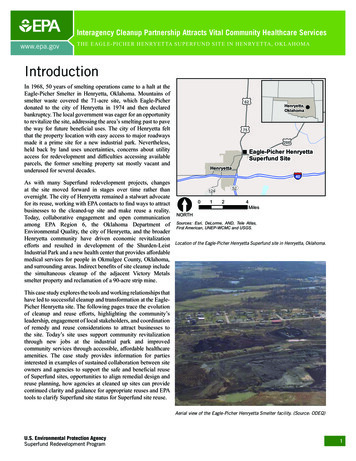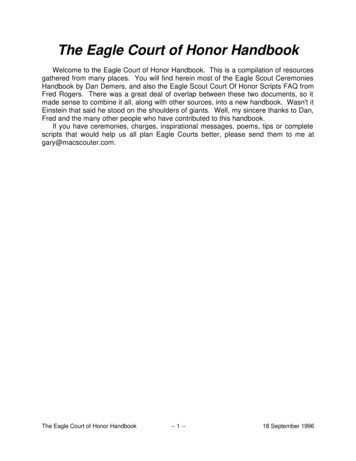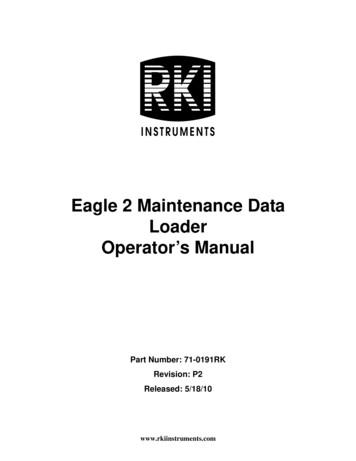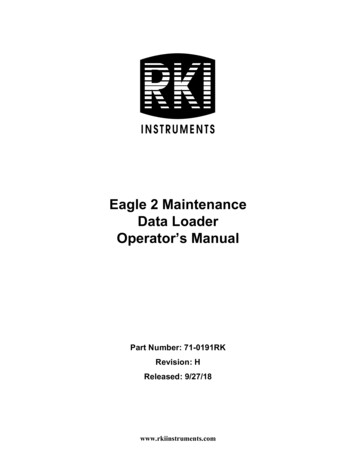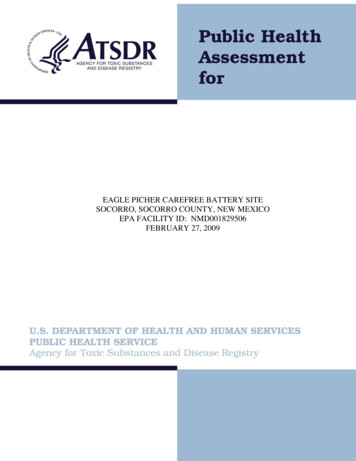
Transcription
EAGLE PICHER CAREFREE BATTERY SITESOCORRO, SOCORRO COUNTY, NEW MEXICOEPA FACILITY ID: NMD001829506FEBRUARY 27, 2009
THE ATSDR PUBLIC HEALTH ASSESSMENT: A NOTE OF EXPLANATIONThis Public Health Assessment was prepared by ATSDR pursuant to the Comprehensive Environmental Response, Compensation, andLiability Act (CERCLA or Superfund) section 104 (i)(6) (42 U.S.C. 9604 (i)(6)), and in accordance with our implementing regulations(42 C.F.R. Part 90). In preparing this document, ATSDR has collected relevant health data, environmental data, and community healthconcerns from the Environmental Protection Agency (EPA), state and local health and environmental agencies, the community, andpotentially responsible parties, where appropriate.In addition, this document has previously been provided to EPA and the affected states in an initial release, as required by CERCLAsection 104 (i)(6)(H) for their information and review. The revised document was released for a 30-day public comment period.Subsequent to the public comment period, ATSDR addressed all public comments and revised or appended the document as appropriate.The public health assessment has now been reissued. This concludes the public health assessment process for this site, unless additionalinformation is obtained by ATSDR which, in the agency’s opinion, indicates a need to revise or append the conclusions previouslyissued.Agency for Toxic Substances & Disease Registry. Julie L. Gerberding, M.D., M.P.H., AdministratorHoward Frumkin, M.D., Dr.P.H., DirectorDivision of Health Assessment and Consultation . . William Cibulas, Jr., Ph.D., DirectorSharon Williams-Fleetwood, Ph.D., Deputy DirectorHealth Promotion and Community Involvement Branch .Hilda Shepeard, Ph.D., M.B.A., ChiefExposure Investigations and Consultation Branch. Susan M. Moore, M.S., ChiefFederal Facilities Assessment Branch. Sandra G. Isaacs, B.S., ChiefSuperfund and Program Assessment Branch .Richard E. Gillig, M.C.P., ChiefUse of trade names is for identification only and does not constitute endorsement by the Public Health Service or the U.S. Department ofHealth and Human Services.Additional copies of this report are available from:National Technical Information Service, Springfield, Virginia(703) 605-6000You May Contact ATSDR Toll Free at1-800-CDC-INFOorVisit our Home Page at: http://www.atsdr.cdc.gov
Eagle Picher Carefree Battery SiteFinal ReleasePUBLIC HEALTH ASSESSMENTEAGLE PICHER CAREFREE BATTERY SITESOCORRO, SOCORRO COUNTY, NEW MEXICOEPA FACILITY ID: NMD001829506Prepared by:U.S. Department of Health and Human ServicesAgency for Toxic Substances and Disease RegistryDivision of Health Assessment and Consultation
ForewordThe Agency for Toxic Substances and Disease Registry, ATSDR, was established by Congressin 1980 under the Comprehensive Environmental Response, Compensation, and Liability Act,also known as the Superfund law. This law set up a fund to identify and clean up our country'shazardous waste sites. The Environmental Protection Agency, the U.S. EPA, and the individualstates regulate the investigation and clean up of the sites.Since 1986, ATSDR has been required by law to conduct a public health assessment at each ofthe sites on the EPA National Priorities List. The aim of these evaluations is to find out if peopleare being exposed to hazardous substances and, if so, whether that exposure is harmful andshould be stopped or reduced. If appropriate, ATSDR also conducts public health assessmentswhen petitioned by concerned individuals. Public health assessments are carried out byenvironmental and health scientists from ATSDR and the states with which ATSDR hascooperative agreements. The public health assessment process allows ATSDR scientists andpublic health assessment cooperative agreement partners flexibility in document format whenpresenting findings about the public health impact of hazardous waste sites. The flexible formatallows health assessors to convey to affected populations important public health messages in aclear and expeditious way.Exposure: As the first step in the evaluation, ATSDR scientists review environmental data tosee how much contamination is at a site, where it is, and how people might come into contactwith it. Generally, ATSDR does not collect its own environmental sampling data but reviewsinformation provided by EPA, other government agencies, businesses, and the public. Whenthere is not enough environmental information available, the report will indicate what furthersampling data are needed.Health Effects: If the review of the environmental data shows that people have or could comeinto contact with hazardous substances, ATSDR scientists evaluate whether or not these contactsmay result in harmful effects. ATSDR recognizes that children, because of their play activitiesand their growing bodies, may be more vulnerable to these effects. As a policy, unless data areavailable to suggest otherwise, ATSDR considers children to be more sensitive and vulnerable tohazardous substances. Thus, the health impact to the children is considered first when evaluatingthe health threat to a community. The health impacts to other high-risk groups within thecommunity (such as the elderly, chronically ill, and people engaging in high risk practices) alsoreceive special attention during the evaluation.ATSDR uses existing scientific information, which can include the results of medical,toxicologic and epidemiologic studies and the data collected in disease registries, to evaluate thepossible health effects that may result from exposures. The science of environmental health isstill developing, and sometimes scientific information on the health effects of certain substancesis not available.Community: ATSDR also needs to learn what people in the area know about the site and whatconcerns they may have about its impact on their health. Consequently, throughout theevaluation process, ATSDR actively gathers information and comments from the people wholive or work near a site, including residents of the area, civic leaders, health professionals, andcommunity groups. To ensure that the report responds to the community's health concerns, ani
Eagle Picher Carefree Battery Site PHAearly version is also distributed to the public for their comments. All the public comments thatrelated to the document are addressed in the final version of the report.Conclusions: The report presents conclusions about the public health threat posed by a site.Ways to stop or reduce exposure will then be recommended in the public health action plan.ATSDR is primarily an advisory agency, so usually these reports identify what actions areappropriate to be undertaken by EPA or other responsible parties. However, if there is an urgenthealth threat, ATSDR can issue a public health advisory warning people of the danger. ATSDRcan also recommend health education or pilot studies of health effects, full-scale epidemiologystudies, disease registries, surveillance studies or research on specific hazardous substances.Comments: If, after reading this report, you have questions or comments, we encourage you tosend them to us.Letters should be addressed as follows:Attention: Manager, ATSDR Record Center Agency for Toxic Substances and Disease Registry,1600 Clifton Road (E-60), Atlanta, GA 30333.ii
Table of ContentsForeword .iSummary .1Background .4Site Description and History. 4Physical Setting and Resource Uses . 5Health Issues and Community Health Concerns . 8Contaminant Sources, Concentrations, and Estimated Exposure Doses .10Contaminant Sources and Migration . 10Contaminant Concentrations and Distribution . 13Groundwater . 13Soil . 14Exposure Doses. 19Public Health Implications.221,1-dichloroethylene (1,1-DCE) . 24Trichloroethylene (TCE or trichloroethene) . 26Child Health Considerations. 30Adequacy of Available Data. 30Conclusions, Recommendations, and Public Health Action Plan .32Conclusions. 32Recommendations. 33Public Health Action Plan. 33Authors, Technical Advisors and Reviewers.34References .35ATSDR Glossary of Environmental Health Terms . A-37List of FiguresFigure 1. Location and topographic map of EP site and surrounding area 6Figure 2. Aerial photograph of EP site and adjacent area showing locations of the sewageimpoundments, former location of lined evaporation lagoons and main EP building 7Figure 3. Demographic map of community surrounding EP site . 9Figure 4. Locations of wells on or down-gradient of EP site . .12Figure 5. TCE trends in selected wells down-gradient of EP site . .17Figure 6. TCE concentration trends in selected wells . . .18Figure 7. 1,1-DCE doses and health effects .25Figure 8. TCE doses and health effects .29iii
Eagle Picher Carefree Battery Site PHAList of TablesTable 1. Groundwater contaminant concentrations in private and municipal drinking waterwells .15Table 2. Concentrations and soil screening values for metals at the EP site .16Table 3. Exposure pathways on or adjacent to the Eagle Picher site, Socorro New Mexico . 20Table 4. TCE and 1,1-DCE doses from groundwater exposure in a residence near the EP site . .21Table 5. VOC doses, health comparison values (CVs), and excess cancer risks from exposureto groundwater at Well B . 23iv
Eagle Picher Carefree Battery Site PHASummaryAs a result of groundwater and soil contamination the Eagle Picher Carefree Battery (EP) sitewas placed on the EPA Superfund National Priorities List in 2007. Although the EP site hasonly been recently added to the EPA NPL list (9/19/07), the EPA and the New MexicoEnvironment Department (NMED) have conducted site environmental sampling and assessmentssince at least 1981 (USACE, 2007). These site evaluations have resulted in regulated closures ofan on-site landfill and waste lagoons, provision of City water to several offsite residences, anddiscontinued use of a public water well due to contamination (this well was shut down due toarsenic concentrations rather than EP site contaminants). Since 1986, the Agency for ToxicSubstances and Disease Registry (ATSDR) has been required by law to conduct a public healthassessment (PHA) at each of the sites on the EPA National Priorities List. The aim of theseevaluations is to find out if people are being exposed to hazardous substances and, if so, whetherthat exposure is harmful and should be stopped or reduced. This document is the ATSDR PHAfor the EP site.The EP site occupies about 173 acres on the western portion of the Rio Grande valley where thefoothills of the Sierra Ladrones Mountains merge with the flat-lying Rio Grande valley. From 1964 until 1976, Eagle Picher developed and used the property to manufacture variousproducts, including electrical circuit boards. From 1977 to 1980, the City of Socorro used anarroyo on the north side of the property as a municipal landfill. The landfill was used fordisposal of waste from residential, commercial, institutional, and recreational facilities. Mostwastes were disposed in the arroyo, but some liquid wastes including sewage and waste oil, weredisposed in a bermed arroyo located west of the primary disposal area. The landfill was closedin 1980 when Eagle Picher reoccupied the site under a lease agreement with the City of Socorro.From 1980 until the late 1990’s Eagle Picher manufactured lead-acid batteries on the site.As a result of manufacturing operations and waste releases on the EP site, groundwater samplesfrom private and public water supply wells adjacent to the EP site have consistently detectedmostly low concentrations of several volatile organic compounds (VOCs). In 1987 and 1988trichloroethylene (TCE) and other volatile organic compounds (VOCs) such as 1,1 dichloroethylene [1,1-DCE], cis-1,2-dichloroethene [cis-1,2-DCE], and tetrachloroethene [PCE],were detected in the City’s Eagle Picher well and other private wells down-gradient (south) ofthe EP site. 1,1-DCE and TCE were the only compounds detected at concentrations above theirhealth-based screening values in water supply wells.Contaminant measurements at the City water distribution point (where municipal water leavesthe water treatment system and enters the distribution pipes) have not detected any EP-relatedcontaminants. Of the four residential drinking water wells (Wells A,B,C, and D) with detectableVOC concentrations, only one (Well B) had 1,1-DCE and TCE concentrations significantlyabove the health-based screening values (at the time this well used for drinking water supply;July 1999). The other private water supply wells had 1,1-DCE and TCE concentrations below orbarely above the drinking water standards.A survey of soil contamination found elevated concentrations of cadmium, chromium, and leadin several areas within the EP site, most notably in the vicinity of sewage impoundments, the1
Eagle Picher Carefree Battery Site PHAbuilding parking lot, and adjacent to a small outbuilding. Analyses of off-site residentialproperties with flood deposits did not indicate metals concentrations above background levels.Based on the available soil sampling data, measured soil concentrations are below levels ofpublic health concern and site specific doses are not calculated.1999 measurements of 1,1-DCE were 67 ppb in Well B, 9 ppb in Well C, 11 ppb in Well D andtrace or non-detectable concentrations in all other residential wells (Table 1). The Well Bdrinking water concentrations result in estimated combined (ingestion plus inhalation plusdermal contact) 1,1-DCE doses of 0.0038 mg/kg/day for adults and 0.0084 mg/kg/day forchildren. Based on the available measured 1,1-DCE concentrations and estimated doses,adverse health effects from past exposure to 1,1-DCE via contaminated drinking water wellsaround the EP site are unlikely to produce any adverse health effects, including cancer.1999 measurements of TCE were 38 ppb in Well B, 5.7 ppb in Well C, 1.4 ppb in Well D andtrace or non-detectable concentrations in all other residential wells (Tables 1 and 2). The Well Bdrinking water concentrations result in estimated combined (ingestion plus inhalation plusdermal contact) TCE doses of 0.0022 mg/kg/day for adults and 0.0048 mg/kg/day for children.Estimated doses at other locations are more than 6 times lower than Well B doses. Based on theavailable measured TCE concentrations and estimated doses, adverse health effects from pastexposure to TCE via contaminated drinking from the contaminated water wells around the EPsite are unlikely to produce any adverse health effects, including cancer.Evaluation of the contaminant distributions and estimated doses, using both children and adultbody weights and intake rates for 1,1-DCE and TCE leads to the following public healthdeterminations; Adverse health effects, including cancer, are unlikely for users of thecontaminated private wells based on recent measured concentrations of VOCs. Residences with contaminated wells are currently being provided with municipalwater. Current exposure to VOCs at these locations is limited to incidental use ofthe wells for irrigation or other outside uses. These exposures are unlikely tocreate adverse health effects. The available information on the historic use and release of VOCs at the EP siteand patterns of groundwater flow is not adequate to determine how long (prior to1999) the residential wells were contaminated. The current distribution of groundwater VOCs suggests that concentrations inresidential wells were not higher in the past. Based on the above findings, past, current and future exposures to VOCs viacontaminated groundwater are “no apparent public health hazard.” Thisdetermination means that exposures to site-related contaminants has or may beoccurring, but at levels unlikely to create any adverse health effects.2
Eagle Picher Carefree Battery Site PHABased on the above conclusions, ATSDR recommends: Continued monitoring of the groundwater contaminants and additional evaluation of thetimes and locations of VOC releases in order to more completely evaluate historiccontaminant concentrations and distributions. Initiation of appropriate groundwater source remediation or management based on thefindings of the ongoing remedial investigation. All future exposures to VOCs should beeliminated by instituting appropriate management practices to ensure that new drinkingwater wells are not developed within the area of the contaminant plume. Expand locations of surface soil sampling to include former paintball facility. Any futuresoil sampling should be conducted using spatially representative multi-incrementanalyses (with at least 30 increments per sample).To ensure community understanding and address future public health issues related to the EPsite, ATSDR will conduct the following public health actions: ATSDR will evaluate future site data and information as provided by the NMED and theEPA and revise the public health conclusions of this health assessment as necessary.3
Eagle Picher Carefree Battery Site PHABackgroundSite Description and HistoryThe former Eagle Picher Carefree Battery site (EP site) consists of approximately 173 acres ofland located about two miles north of the City of Socorro, Socorro County, New Mexico. Thishistory of the EP site is summarized from the “ Expanded Site Inspection and RemedialInvestigation Report” prepared for the US Army Corps Engineers (April 2007). The property,which is currently owned by the City of Socorro, was formerly owned by the United Statesgovernment and was used as a Civilian Conservation Corps barracks circa 1932. The propertywas used by the State of New Mexico as a tuberculosis sanitarium from 1936 until 1956. Duringthis period, septic waste was discharged into unlined impoundments in the southeast portion ofthe property (USACE, 2007).The City of Socorro acquired the property after closure of the sanitarium and sold it to EaglePicher, Inc. in 1964. From 1964 until 1976, Eagle Picher developed and used property tomanufacture various products, including electrical circuit boards. Domestic sewage andindustrial wastes from the manufacturing operations were released into the unlinedimpoundments during this time period (USACE, 2007).In 1976, Eagle Picher, Inc. released the property back to the City of Socorro which then leasedthe building to RayChester of Socorro, Inc. (from 1977 to 1980) for the purpose of jewelrymanufacturing (no chlorinated solvents were used or discharged during this period; USACE,2007). Also during this time period, the City of Socorro used an arroyo on the north side of theproperty as a municipal landfill. The landfill was used for disposal of waste from residential,commercial, institutional, and recreational facilities. Most wastes were disposed in the arroyo,but some liquid wastes including sewage and waste oil, were disposed in a bermed arroyolocated west of the primary disposal area.The landfill was closed in 1980 when Eagle Picher reoccupied the site under a lease agreementwith the City of Socorro. From 1980 until the late 1990’s Eagle Picher manufactured lead-acidbatteries on the site. During this time, Eagle Picher constructed two lined evaporation lagoonsfor disposal of industrial wastes. These waste lagoons were located south of the main buildingand west of the existing unlined impoundments. The unlined impoundments were used fordomestic waste until the City installed a septic system in 1989. The lined lagoons were closed aspart of a Resource Conservation and Recovery Act (RCRA) operation in the late 1990s.In 2005, the City leased approximately 11 acres of the site, including the manufacturing buildingand surrounding property, for recreational and commercial use as a motocross track andmotorcycle repair facility. The area of the former tuberculosis sanitarium was also used forrecreation as an outdoor paintball facility. In July and August of 2006, flash flooding damagedthe manufacturing building and motocross track. Soil erosion during the flooding exposed leadbattery straps/plates and exposed two wells in the area of the former sanitarium. Recreationaland commercial use of the property ceased following the floods and the site is currently vacantand unused.As a result of groundwater and soil contamination the site was place on the EPA SuperfundNational Priorities List in 2007. Although the EP site has only been recently added to the EPANPL list (9/19/07), the EPA and the New Mexico Environment Department (NMED) have4
Eagle Picher Carefree Battery Site PHAconducted site environmental sampling and assessments since at least 1981 (USACE, 2007).These site evaluations (as summarized at the EPA Superfund web nfo.cfm?id 0600805 and the various site reports,USACE, 2007) have resulted in regulated closure of the City landfill, the lined evaporationlagoons, provision of City water to several offsite residences, and discontinued use of a Citywater well due to contamination. Relevant conclusions and data from these various reports arepresented and discussed in following sections of this document as they relate to this assessmentof public health and potential community exposures to EP site related contaminants.Physical Setting and Resource UsesThe physical setting of the EP site is a description of the geologic and hydrologic conditions thatdetermine how contaminants released at the site may migrate to offsite areas or result incontaminant exposures at either on or offsite locations. Figure 1 shows the EP site boundaries inrelation to the surrounding terrain. The EP site is on the western portion of the Rio Grandevalley where the foothills of the Sierra Ladrones Mountains merge with the flat-lying Rio Grandevalley. The resulting terrain slopes to the south and southeast with relatively steep gradientsbetween dry washes or arroyos.The arroyos are usually dry stream beds that serve as drainage courses for infrequent flash floodssuch as those that occurred in July and August of 2006. Average annual precipitation is less than10 inches per year and the region is considered arid to semi-arid. As a result of the limitedprecipitation, both the EP site and the surrounding area are sparsely vegetated. Evaporationgreatly exceeds precipitation such that groundwater is predominately derived by recharge fromthe Rio Grande River, the intermittent streams, related irrigation canals, or applied irrigationwater. Several groundwater studies of the EP site (as summarized in USACE, 2007) indicatethat groundwater flow from the EP site moves southward.The depth to the water table is generally quite shallow with the topographically higher areashaving depths of 80 to 120 feet (below ground level; bgl) and the water table occurring at depthsof 20 to 60 feet bgl in lower or flat-lying areas (from well and water data transmitted to ATSDR;Eagle Picher Carefree Batteries Site, Expanded Site Inspection CD, April 2007). Thegroundwater gradient is about 5 feet per mile (or 0.0009 ft/ft; USACE, 2007).Drinking water for the City of Socorro municipal system and private residences is obtained fromwells. The locations of these wells and other features of the EP site and surrounding communityare shown in Figure 2. As previously stated, three of the down-gradient residences wereconnected with City water (although the wells may still be used for non-potable purposes) andone of the municipal wells used by the City of Socorro (the Olsen Well) is no longer used. Anadditional municipal supply well, located on the EP site (the Eagle Picher Well), has contaminantdetections at concentrations below applicable drinking water standards.5
Eagle Picher Carefree Battery Site PHAFigure 1. Location and topographic map of EP site and surrounding area (from USACE, 2007).6
Eagle Picher Carefree Battery Site PHAFigure 2. Aerial photograph of EP site and adjacent area showing locations of the sewageimpoundments, former location of lined evaporation lagoons and main EP building. The formertuberculosis sanitarium and paintball course is immediately west of the property boundary. Notethat the property outline of Figure 1 is much larger than the EP site boundary shown in thisfigure (from USACE, 2007).7
Eagle Picher Carefree Battery Site PHAHealth Issues and Community Health ConcernsDiscussions with representatives of the City of Socorro, the Socorro Community Health Council,the Socorro County Health Office, the New Mexico Health and Environment Departments, and areporter for the El Defensor Chieftan (the local Socorro newspaper) have all indicated that therehas been little vocal community concern about potential public health issues related to the EPsite. Periodic news articles in the El Defensor Chieftan have reported on the status of the sitewith regard to groundwater and soil monitoring and contamination, site cleanup and assessmentactivities, and the effects of the 2006 floods on the site and adjacent properties.At the request of EPA Region 6, ATSDR has conducted two reviews of soil contamination at theEP site with regard to exposures related to the former motocross facility (New Venture RacingGrand Prix Track). These reviews were based on data assessments conducted before and afterthe 2006 flood events (4/8/2005 and 8/17/2006). Based on the data available, the initial reviewfound that exposures to site soil via motorcycle riding and associated activities were below levelsof health concern and that soil exposures could be further reduced by implementing dustmanagement and suppression procedures.The second data review, conducted after the 2006 floods, observed that site conditions hadchanged due to erosion from the floods and that motocross operations should be suspended untila complete site characterization and possible remedial actions could be completed. Although thecommercial motocross facility has suspended activities, access to the EP site is not restricted andneighbors report that motorcycle riders continue to use the track.Groundwater contaminants have also been detected in drinking water wells at and down-gradientof the EP site. The potential doses and health implications from exposures to contaminants indrinking water and site soils due to these activities will be evaluated in this assessment. Oneother possible health issue has been mentioned by a representative of the Socorro CommunityHealth Council. That issue is whether former EP site workers may have been exposed tohazardous chemicals as a result of occupational activities when the EP site was operating.Although that issue is beyond the scope of this PHA, ATSDR will present this issue toappropriate representatives of the NMDOH for their consideration.Figure 3 is a map of the EP site and surrounding community that shows the number of peopleliving within one mile of the site boundary (656 people based on 2000 census data). This mapalso shows the number of people comprising sensitive sub-populations within this area, such asyoung children, women of child-bearing age, and adults over age 65. These sub-populations arehighlighted because they may, for a number of reasons, be especially susceptible to thetoxicological effects of site-related contaminants. Those potential health effects are presented inthe following section on “Public Health Implications.”8
Eagle Picher Carefree Battery Site PHAFigure 3. Demographic map of community surrounding EP site. This map shows the number
were detected in the City's Eagle Picher well and other private wells down-gradient (south) of the EP site. 1,1-DCE and TCE were the only compounds detected at concentrations above their health-based screening values in water supply wells. Contaminant measurements at the City water distribution point (where municipal water leaves



